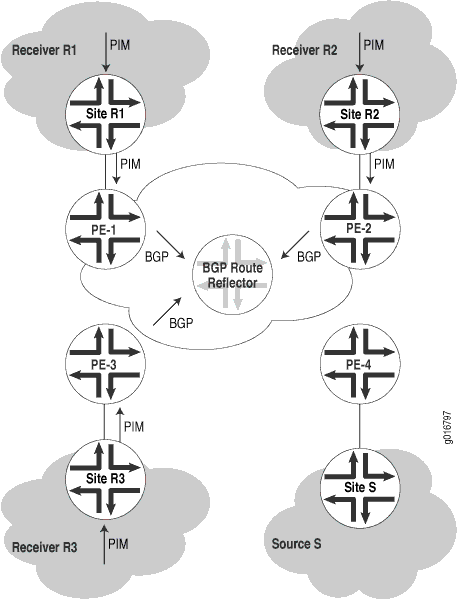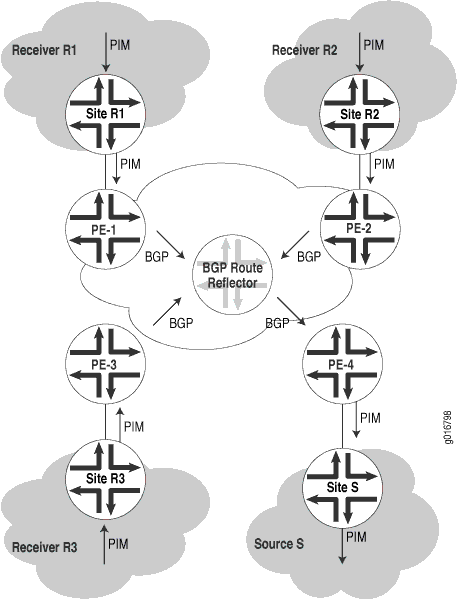Multiprotocol BGP MVPNs Overview
Comparison of Draft Rosen Multicast VPNs and Next-Generation Multiprotocol BGP Multicast VPNs
There are several multicast applications driving the deployment of next-generation Layer 3 multicast VPNs (MVPNs). Some of the key emerging applications include the following:
Layer 3 VPN multicast service offered by service providers to enterprise customers
Video transport applications for wholesale IPTV and multiple content providers attached to the same network
Distribution of media-rich financial services or enterprise multicast services
Multicast backhaul over a metro network
There are two ways to implement Layer 3 MVPNs. They are often referred to as dual PIM MVPNs (also known as “draft-rosen”) and multiprotocol BGP (MBGP)-based MVPNs (the “next generation” method of MVPN configuration). Both methods are supported and equally effective. The main difference is that the MBGP-based MVPN method does not require multicast configuration on the service provider backbone. Multiprotocol BGP multicast VPNs employ the intra-autonomous system (AS) next-generation BGP control plane and PIM sparse mode as the data plane. The PIM state information is maintained between the PE routers using the same architecture that is used for unicast VPNs. The main advantage of deploying MVPNs with MBGP is simplicity of configuration and operation because multicast is not needed on the service provider VPN backbone connecting the PE routers.
Using the draft-rosen approach, service providers might experience control and data plane scaling issues associated with the maintenance of two routing and forwarding mechanisms: one for VPN unicast and one for VPN multicast. For more information on the limitations of Draft Rosen, see draft-rekhter-mboned-mvpn-deploy.
MBGP Multicast VPN Sites
The main characteristics of MBGP MVPNs are:
They extend Layer 3 VPN service (RFC 4364) to support IP multicast for Layer 3 VPN service providers.
They follow the same architecture as specified by RFC 4364 for unicast VPNs. Specifically, BGP is used as the provider edge (PE) router-to-PE router control plane for multicast VPN.
They eliminate the requirement for the virtual router (VR) model (as specified in Internet draft draft-rosen-vpn-mcast, Multicast in MPLS/BGP VPNs) for multicast VPNs and the RFC 4364 model for unicast VPNs.
They rely on RFC 4364-based unicast with extensions for intra-AS and inter-AS communication.
An MBGP MVPN defines two types of site sets, a sender site set and a receiver site set. These sites have the following properties:
Hosts within the sender site set can originate multicast traffic for receivers in the receiver site set.
Receivers outside the receiver site set should not be able to receive this traffic.
Hosts within the receiver site set can receive multicast traffic originated by any host in the sender site set.
Hosts within the receiver site set should not be able to receive multicast traffic originated by any host that is not in the sender site set.
A site can be in both the sender site set and the receiver site set, so hosts within such a site can both originate and receive multicast traffic. For example, the sender site set could be the same as the receiver site set, in which case all sites could both originate and receive multicast traffic from one another.
Sites within a given MBGP MVPN might be within the same organization or in different organizations, which means that an MBGP MVPN can be either an intranet or an extranet. A given site can be in more than one MBGP MVPN, so MBGP MVPNs might overlap. Not all sites of a given MBGP MVPN have to be connected to the same service provider, meaning that an MBGP MVPN can span multiple service providers.
Feature parity for the MVPN extranet functionality or overlapping MVPNs on the Junos Trio chipset is supported in Junos OS Releases 11.1R2, 11.2R2, and 11.4.
Another way to look at an MBGP MVPN is to say that an MBGP MVPN is defined by a set of administrative policies. These policies determine both the sender site set and the receiver site set. These policies are established by MBGP MVPN customers, but implemented by service providers using the existing BGP and MPLS VPN infrastructure.
See Also
Multicast VPN Standards
MBGP MVPNs are defined in the following IETF Internet drafts:
Internet draft draft-ietf-l3vpn-2547bis-mcast-bgp-03.txt, BGP Encodings for Multicast in MPLS/BGP IP VPNs
Internet draft draft-ietf-l3vpn-2547bis-mcast-02.txt, Multicast in MPLS/BGP IP VPNs
PIM Sparse Mode, PIM Dense Mode, Auto-RP, and BSR for MBGP MVPNs
You can configure PIM sparse mode, PIM dense mode, auto-RP, and bootstrap router (BSR) for MBGP MVPN networks:
PIM sparse mode—Allows a router to use any unicast routing protocol and performs reverse-path forwarding (RPF) checks using the unicast routing table. PIM sparse mode includes an explicit join message, so routers determine where the interested receivers are and send join messages upstream to their neighbors, building trees from the receivers to the rendezvous point (RP).
PIM dense mode—Allows a router to use any unicast routing protocol and performs reverse-path forwarding (RPF) checks using the unicast routing table. Packets are forwarded to all interfaces except the incoming interface. Unlike PIM sparse mode, where explicit joins are required for packets to be transmitted downstream, packets are flooded to all routers in the routing instance in PIM dense mode.
Auto-RP—Uses PIM dense mode to propagate control messages and establish RP mapping. You can configure an auto-RP node in one of three different modes: discovery mode, announce mode, and mapping mode.
BSR—Establishes RPs. A selected router in a network acts as a BSR, which selects a unique RP for different group ranges. BSR messages are flooded using a data tunnel between PE routers.
See Also
MBGP-Based Multicast VPN Trees
MBGP-based MVPNs (next-generation MVPNs) are based on Internet drafts and extend unicast VPNs based on RFC 2547 to include support for IP multicast traffic. These MVPNs follow the same architectural model as the unicast VPNs and use BGP as the provider edge (PE)-to-PE control plane to exchange information. The next generation MVPN approach is based on Internet drafts draft-ietf-l3vpn-2547bis-mcast.txt, draft-ietf-l3vpn-2547bis-mcast-bgp.txt, and draft-morin-l3vpn-mvpn-considerations.txt.
MBGP-based MVPNs introduce two new types of tree:
| Inclusive tree |
A single multicast distribution tree in the backbone carrying all the multicast traffic from a specified set of one or more MVPNs. An inclusive tree carrying the traffic of more than one MVPN is an aggregate inclusive tree. All the PEs that attach to MVPN receiver sites using the tree belong to that inclusive tree. |
| Selective tree |
A single multicast distribution tree in the backbone carrying traffic for a specified set of one or more multicast groups. When multicast groups belonging to more than one MVPN are on the tree, it is called an aggregate selective tree. |
By default, traffic from most multicast groups can be carried by an inclusive tree, while traffic from some groups (for example, high bandwidth groups) can be carried by one of the selective trees. Selective trees, if they contain only those PEs that need to receive multicast data from one or more groups assigned to the tree, can provide more optimal routing than inclusive trees alone, although this requires more state information in the P routers.
An MPLS-based VPN running BGP with autodiscovery is used as the basis for a next-generation MVPN. The autodiscovered route information is carried in MBGP network layer reachability information (NLRI) updates for multicast VPNs (MCAST-VPNs). These MCAST-VPN NLRIs are handled in the same way as IPv4 routes: route distinguishers are used to distinguish between different VPNs in the network. These NLRIs are imported and exported based on the route target extended communities, just as IPv4 unicast routes. In other words, existing BGP mechanisms are used to distribute multicast information on the provider backbone without requiring multicast directly.
For example, consider a customer running Protocol-Independent Multicast (PIM) sparse mode in source-specific multicast (SSM) mode. Only source tree join customer multicast (c-multicast) routes are required. (PIM sparse mode in anysource multicast (ASM) mode can be supported with a few enhancements to SSM mode.)
The customer multicast route carrying a particular multicast source S needs to be imported only into the VPN routing and forwarding (VRF) table on the PE router connected to the site that contains the source S and not into any other VRF, even for the same MVPN. To do this, each VRF on a particular PE has a distinct VRF route import extended community associated with it. This community consists of the PE router's IP address and local PE number. Different MVPNs on a particular PE have different route imports, and for a particular MVPN, the VRF instances on different PE routers have different route imports. This VRF route import is auto-configured and not controlled by the user.
Also, all the VRFs within a particular MVPN will have information about VRF route imports for each VRF. This is accomplished by “piggybacking” the VRF route import extended community onto the unicast VPN IPv4 routes. To make sure a customer multicast route carrying multicast source S is imported only into the VRF on the PE router connected to the site contained the source S, it is necessary to find the unicast VPN IPv4 route to S and set the route target of the customer multicast route to the VRF import route carried by the VPN IPv4 route just found.
The process of originating customer multicast routes in an MBGP-based MVPN is shown in Figure 1.
In the figure, an MVPN has three receiver sites (R1, R2, and R3) and one source site (S). The site routers are connected to four PE routers, and PIM is running between the PE routers and the site routers. However, only BGP runs between the PE routers on the provider's network.
When router PE-1 receives a PIM join message for (S,G) from site router R1, this means that site R1 has one or more receivers for a given source and multicast group (S,G) combination. In that case, router PE-1 constructs and originates a customer multicast route after doing three things:
-
Finding the unicast VPN IPv4 router to source S
-
Extracting the route distinguisher and VRF route import form this route
-
Putting the (S,G) information from the PIM join, the router distinguisher from the VPN IPv4 route, and the route target from the VRF route import of the VPN IPv4 route into a MBGP update
The update is distributed around the VPN through normal BGP mechanisms such as router reflectors.

What happens when the source site S receives the MBGP information is shown in Figure 2. In the figure, the customer multicast route information is distributed by the BGP route reflector as an MBGP update.
The provider router PE-4 will then:
-
Receive the customer multicast route originated by the PE routers and aggregated by the route reflector.
-
Accept the customer multicast route into the VRF for the correct MVPN (because the VRF route import matches the route target carried in the customer multicast route information).
-
Create the proper (S,G) state in the VRF and propagate the information to the customer routers of source site S using PIM.

See Also
Change History Table
Feature support is determined by the platform and release you are using. Use Feature Explorer to determine if a feature is supported on your platform.
